Pavel Acosta’s site-specific artwork, “Wallscape,” was installed directly upon a wall in El Museo del Barrio’s permanent collection gallery. The large scale collage was featured in El Museo’s 2013 biennial exhibition “La Bienal 2013: HERE IS WHERE WE JUMP” .

ART (inter)’s Keith Schweitzer leads us in conversation with the artist:
KS: You recently installed an artwork directly upon a wall in El Museo del Barrio’s Permanent Collection gallery. The wall is scraped almost completely raw of paint, leaving only a large rectangular section at the wall’s center, within which we find a meticulously detailed collage. Please explain the collage and the process used to create it.
PA: My work at El Museo del Barrio is titled “Wallscape.”
In the process of making it I actually scraped the whole wall. I lifted all the existing layers of paint I found on the wall — about five of them— until reaching the brown paper of the sheetrock. Only then, I started pasting the scraped paint chips back again, to make a collage. It has been a long process that always starts by classifying the different textures and colors found in my scrapings. Although the material found was pretty homogeneous, there were different tones of white and beige, which allowed me to re-create the forms and contrasts in the picture.

I wanted to reproduce the piece that was in front of the wall I was assigned to. I was not thinking of any specific image, but Macarulla’s painting was perfect. It is a very challenging image, colorful and baroque, and I needed to achieve it with a very limited palette. On the other hand, this process is a way for me to engage in the dialog with the history of the institution, because these walls have accumulated layers and layers of paint that relate the stories which other artists have come to tell, throughout the years.
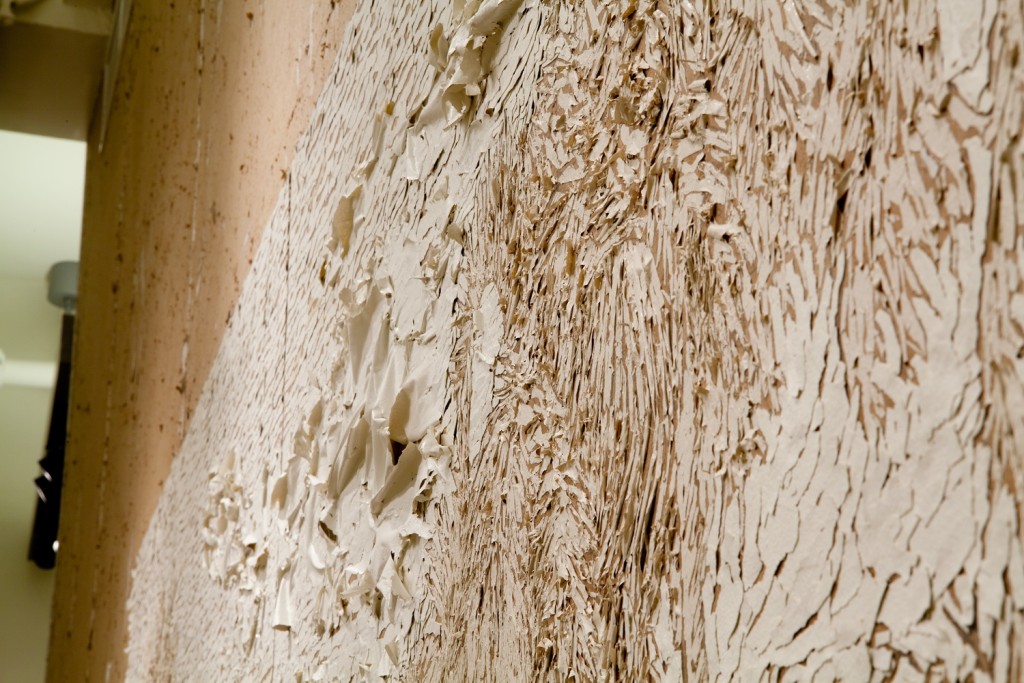
KS: Years back, you began a series, “Stolen Paint,” while living in Havana, Cuba. Please describe this series and the motivations behind it.
PA: Back then, I decided I needed to find the way to make a living as an artist, and I did it through stealing —in the middle of the economic crisis in Cuba everyone was doing that. As a painter I use pigments, and I realized I could obtain them from anywhere in the city without buying expensive art materials. The streets of Havana are filled with aging and falling bits of paint, as buildings and objects are not regularly maintained. I started scraping layers of paint and using them to create collages on canvas and on paper. I found a range of possibilities this way. This variety made every collage different. The quality of the paint chips would determine the look and style of the work. I developed an ability to adapt myself to whatever I found, and I thought this was interesting, both formally and conceptually. The recycling and re-utilizing of found materials somehow echoed the whole Cuban experience of the time.
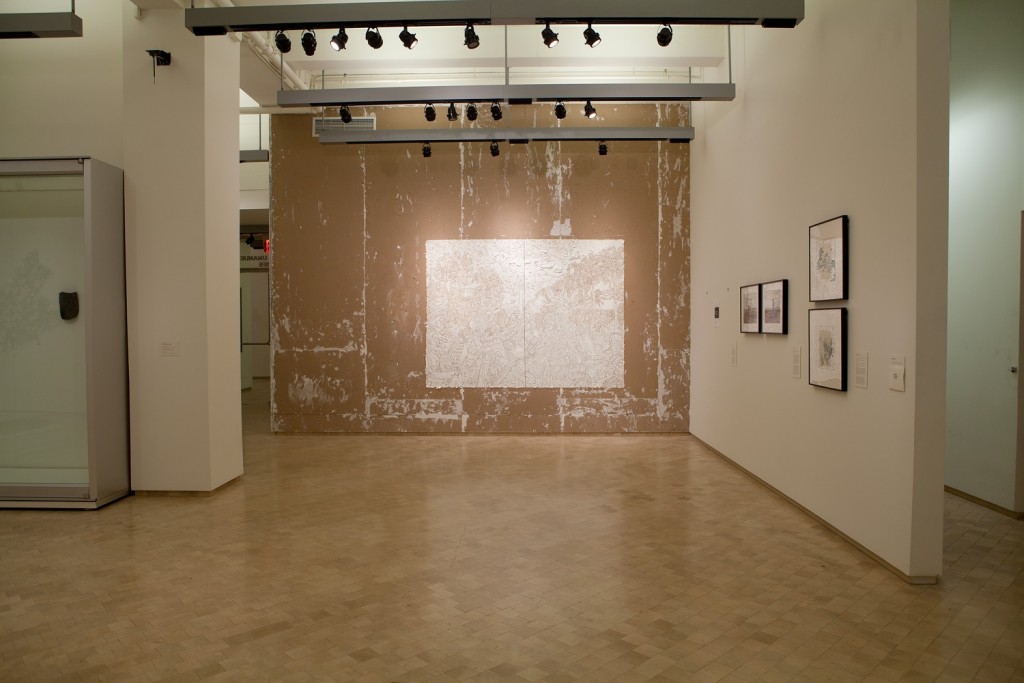
KS: While viewing your “Wallscape” at El Museo, there is no placard or signage to indicate who or what we are looking at. It’s as if a vandal broke into the museum, destroyed a wall, and left behind a gift in the form of an artwork. Gazing across the gallery, we realize that what we’ve been looking at is a reproduction of Manuel Macarulla’s painting, “Goat Song #5: Tumult on George Washington Avenue.” You’ve previously described yourself as a thief and here appear to be a vandal. Are you either of these things?
PA: Sure. I am possibly a thief and definitely a vandal. However, I am not sure whether it is a bad thing to be. I have been destroying one of the Museo’s walls, and copying another artist. Only I did not break in, they just let me in this time.
KS: Why did you choose Manuel Macarulla’s painting?
PA: I didn’t choose that specific work; the curators did. They assigned me that wall, and Macarulla´s work was across from the wall. All I knew was I wanted to reproduce whatever work was in front of my wall; even a sculpture if that was the case. I am very happy it was Macarulla’s though, because of what I explained before.
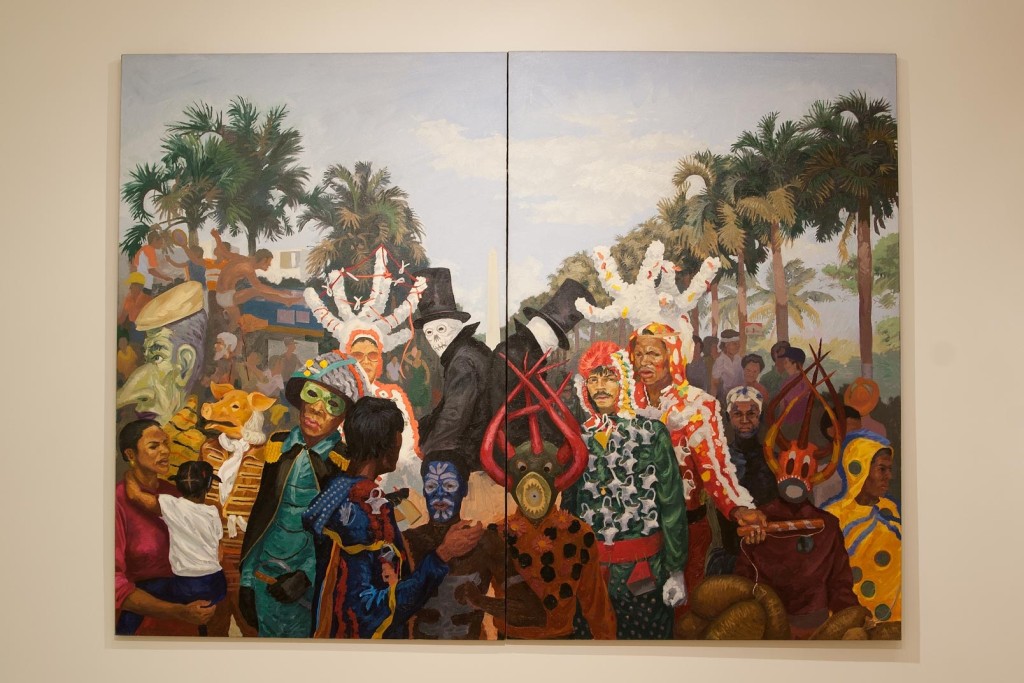
Manuel Macarulla’s painting, “Goat Song #5: Tumult on George Washington Avenue.”
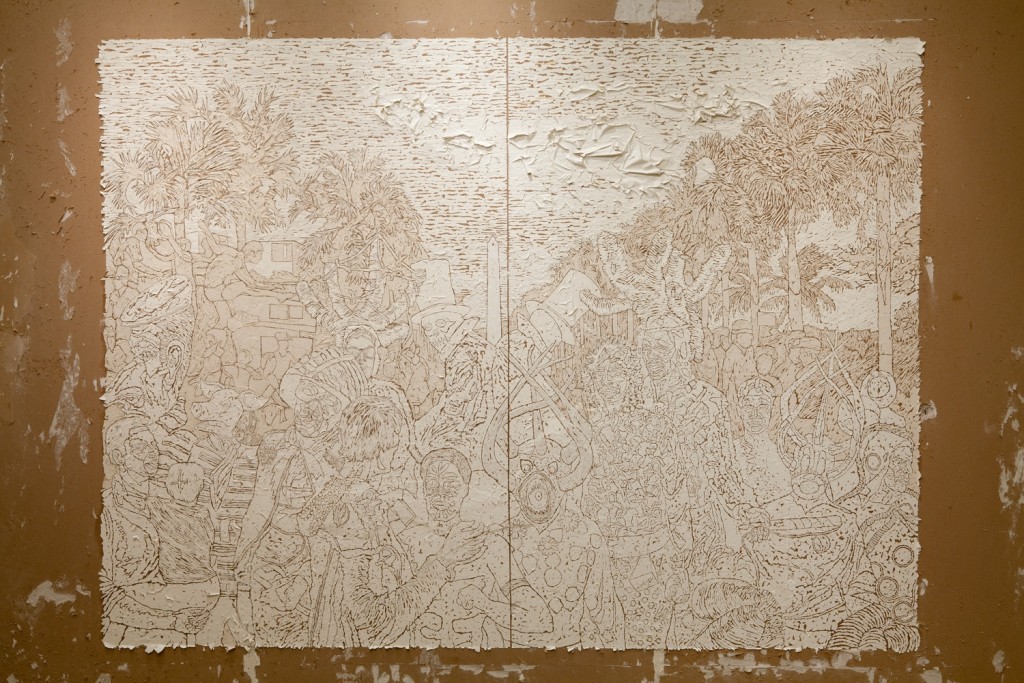
Pavel Acosta’s Wallscape at El Museo del Barrio, 2013
KS: How long have you been living and working in New York? Do you feel that New York has influenced your work and artistic practices in any form? How has your experience at El Museo affected you?
PA: I came to New York two years ago, and the experience has definitively changed my work. I still am in the process of digesting the vastness of what this city offers visually, and even materially. Looking at my former work in Cuba, I realize that the person who started the Stolen Paint series has very different concerns now. The links between the technique employed and the context where my collages were generated have definitively disappeared. I felt I had to re-think my approach to painting and to art as a whole, in relationship with new subjects and issues. I am opening up to new possibilities, including developing site-specific projects, such as Wallscape. This is only my first intervention in a U.S. Museum, where the relationship between the artist and the institution is quite different. I really appreciate this great opportunity at El Museo.
“Wallscape” will be featured as part of El Museo’s Bienal, but in the context of the permanent collection galleries, and it will be on view for almost a year. I look forward to the reaction of the audience to the dynamics that this work activates inside the gallery.
Pavel Acosta: pavelacosta.com
Keith Schweitzer: keithschweitzer.com
Video of the installation: https://vimeo.com/67144633
El Museo del Barrio: elmuseo.org
1230 Fifth Avenue, New York, NY 10029 (at 104th Street)
Since its first edition in 1999, La Bienal – formerly known as The (S) Files – has been a significant means for creating ties between institutions and artists, while building networks and opportunities for a wide variety of talented Latino artists.
images courtesy of El Museo del Barrio and the artist

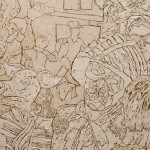
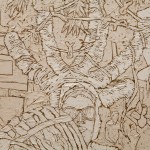
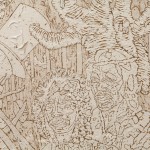


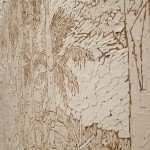
No comments yet.